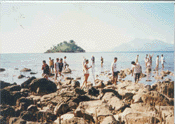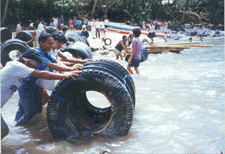
The Project
 In July, 1997, two coastal barangays (communities) along Gingoog Bay
in Balingoan, Misamis Oriental were identified as pilot sites for Sustainable Coastal
Resource Management Project (SCRMP) which was being implemented by the TOUCH Foundation
and the Local Government Support Project (LGSP) – Region 10. These two communities
were Lapinig and Mantangale. Touch Foundation is a non-Government organization working
with the Canadian International Development Assistance (CIDA) in the implementation of the
aforementioned project.
In July, 1997, two coastal barangays (communities) along Gingoog Bay
in Balingoan, Misamis Oriental were identified as pilot sites for Sustainable Coastal
Resource Management Project (SCRMP) which was being implemented by the TOUCH Foundation
and the Local Government Support Project (LGSP) – Region 10. These two communities
were Lapinig and Mantangale. Touch Foundation is a non-Government organization working
with the Canadian International Development Assistance (CIDA) in the implementation of the
aforementioned project.
One of the very first activities undertaken by the project after the Memorandum of
Agreement was signed by the LGSP and the Barangay Captains was to conduct a Rapid Rural
Appraisal (RRA) to identify community needs, analyze potential problems and difficulties
as well as validate and update the barangay profiles.
Intensive information dissemination, study tours, training, ecological awareness and
skills development activities were conducted so that the community would better understand
the purpose and objectives of the Project. In time, the community started to appreciate
the value of sustainable utilization of the coastal resources. It is also worth noting
that the Project gained the support of the Balingoan Municipal Mayor and the Sangguniang
Bayan (SB).
Institutional arrangements were formalized with the formation of a the Balingoan LGSP
Project Management Team (BLPMT). Likewise, BFARMCs with representatives from various
sectors were created in Lapinig and Mantangale. These bodies maintain and manage the
project, especially livelihood and conservation activities. Bantay Dagat fish wardens were
also deputized under the program. To date, there are around 46 fish wardens including
women and children who serve as "informers" of violators. Linkages and
partnerships have been forged with different government organizations, non-government
organizations, and the local businessmen alike.
SCRM adheres to the principle of participatory democracy. Decision-making is through
consensus based on the belief that everyone has the responsibility to manage the resource
base and therefore accountable for its proper management. Gender sensitivity is also
incorporated in the concept of the project.
The project was able to conduct rehabilitation activities in the two barangays
including reforestation of eight hectares of mangrove areas in Barangay Lapinig alone.
This inspired other nearby communities to follow suit. They also embarked on constructing
and installing artificial reefs to assist rehabilitation in areas with poor coral reef
conditions. Further, a 10-hectare marine sanctuary had been declared in Barangay Lapinig.
This prompted the provision of alternative livelihood for the fisherfolks such as Guso
farming and fisherfolk vegetable garden, in addition to the designation of fishing
grounds.

